Reconfigurable Radiation Pattern of Planar Antenna Using Metamaterial for 5G Applications
Abstract
1. Introduction
2. Design and Characterization of the Proposed MM Structure
2.1. Simulation Results and Experimental Validation
2.2. Reconfigurable MM Structure
3. MM for Beam Deflection Antenna
3.1. Dipole Antenna Design
3.2. Theoretical Basis of Beam Deflection
3.3. Antenna Beam Deflection
4. Conclusions
Author Contributions
Funding
Conflicts of Interest
References
- Wang, C.X.; Haider, F.; Gao, X.; You, X.H.; Yang, Y.; Yuan, D.; Hepsaydir, E. Cellular architecture and key technologies for 5G wireless communication networks. IEEE Commun. Mag. 2014, 52, 122–130. [Google Scholar] [CrossRef]
- Selinis, I.; Katsaros, K.; Allayioti, M.; Vahid, S.; Tafazolli, R. The Race to 5G Era; LTE and Wi-Fi. IEEE Access 2018, 6, 56598–56636. [Google Scholar] [CrossRef]
- Tang, M.C.; Zhou, B.; Ziolkowski, R.W. Low-Profile, Electrically Small, Huygens Source Antenna with Pattern-Reconfigurability That Covers the Entire Azimuthal Plane. IEEE Trans. Antennas Propag. 2017, 65, 1063–1072. [Google Scholar] [CrossRef]
- Mirkamali, A.; Deban, R.; Siaka, F.; Laurin, J.J. Fast and low-cost beam steering using an agile mechanical feed system for exciting circular arrays. IET Microw. Antennas Propag. 2016, 10, 378–384. [Google Scholar] [CrossRef]
- Liang, Z.; Liang, Z.; Li, Y.; Liu, J.; Qin, J.; Long, Y. Reconfigurable Microstrip Magnetic Dipole Antenna with Switchable Conical Beams for Aerial Drone Applications. IEEE Access 2019, 7, 31043–31054. [Google Scholar] [CrossRef]
- Hussain, R.; Khan, M.U.; Sharawi, M.S. An Integrated Dual MIMO Antenna System with Dual-Function GND-Plane Frequency-Agile Antenna. IEEE Antennas Wirel. Propag. Lett. 2018, 17, 142–145. [Google Scholar] [CrossRef]
- Karabey, O.H.; Mehmood, A.; Ayluctarhan, M.; Braun, H.; Letz, M.; Jakoby, R. Liquid crystal based phased array antenna with improved beam scanning capability. Electron. Lett. 2014, 50, 426–428. [Google Scholar] [CrossRef]
- Zaidi, A.M.; Imam, S.A.; Kanaujia, B.K.; Rambabu, K.; Srivastava, K.; Beg, M.T. A new dual band 4× 4 butler matrix with dual band 3 dB quadrature branch line coupler and dual band 45° phase shifter. AEU-Int. J. Electron. Commun. 2019, 99, 215–225. [Google Scholar] [CrossRef]
- Papasimakis, N.; Luo, Z.; Shen, Z.X.; De Angelis, F.; Di Fabrizio, E.; Nikolaenko, A.E.; Zheludev, N.I. Graphene in a photonic metamaterial. Opt. Express 2010, 18, 8353–8359. [Google Scholar] [CrossRef]
- Othman, M.A.K.; Guclu, C.; Capolino, F. Graphene-dielectric composite metamaterials: Evolution from elliptic to hyperbolic wavevector dispersion and the transverse epsilon-near-zero condition. J. Nanophoton. 2013, 7, 73089. [Google Scholar] [CrossRef]
- Kowerdziej, R.; Stańczyk, T.; Parka, J. Electromagnetic simulations of tunable terahertz metamaterial infiltrated with highly birefringent nematic liquid crystal. Crystals 2015, 42, 430–434. [Google Scholar] [CrossRef]
- Kowerdziej, R.; Krupka, J.; Nowinowski Kruszelnicki, E.; Olifierczuk, M.; Parka, J. Microwave complex permittivity of voltage-tunable nematic liquid crystals measured in high resistivity silicon transducers. Phys. Lett. 2013, 102, 102904. [Google Scholar] [CrossRef]
- Wang, J.; Yang, R.; Xu, J.; Tian, J.; Ma, R.; Zhang, W. Polarization-Controlled and Flexible Single-/Penta-Band Metamaterial Absorber. Materials 2018, 11, 1619. [Google Scholar] [CrossRef] [PubMed]
- Lu, T.; Zhang, D.; Qiu, P.; Lian, J.; Jing, M.; Yu, B.; Wen, J.; Zhuang, S. Dual-Band Perfect Metamaterial Absorber Based on an Asymmetric H-Shaped Structure for Terahertz Waves. Materials 2018, 11, 2193. [Google Scholar] [CrossRef] [PubMed]
- Majumder, B.; Kandasamy, K.; Ray, K.P. A Zero Index Based Meta-Lens Loaded Wideband Directive Antenna Combined with Reactive Impedance Surface. IEEE Access 2018, 6, 28746–28754. [Google Scholar] [CrossRef]
- Wu, Q.; Zhang, K.; Meng, F.Y.; Li, L.W. Electromagnetic characteristics of metamaterial cloak covered dielectric cylinder illuminated by electric line source. IET Microw. Antennas Propag. 2010, 4, 1680–1688. [Google Scholar] [CrossRef]
- Gao, J.; Zhang, Y.; Sun, Y.; Wu, Q. Ultra-Wide Band and Multifunctional Polarization Converter Based on Dielectric Metamaterial. Materials 2019, 12, 3857. [Google Scholar] [CrossRef]
- Esmail, B.A.; Majid, H.B.; Abidin, Z.B.Z.; Dahlan, S.H.B.; Himdi, M.; Kamarudin, M.R.; Rahim, M.K. Dual mode modified double square ring resonator structure at 76 GHz. Microw. Opt. Technol. Lett. 2019, 61, 1678–1682. [Google Scholar] [CrossRef]
- Jiang, H.; Si, L.M.; Hu, W.; Lv, X. A Symmetrical Dual-Beam Bowtie Antenna with Gain Enhancement Using Metamaterial for 5G MIMO Applications. IEEE Photon. J. 2019, 11, 1–9. [Google Scholar] [CrossRef]
- Dawar, P.; Raghava, N.S.; De, A. UWB Metamaterial-Loaded Antenna for C-Band Applications. Int. J. Antennas Propag. 2019, 2019. [Google Scholar] [CrossRef]
- Barati, H.; Fakheri, M.H.; Abdolali, A. Experimental demonstration of metamaterial-assisted antenna beam deflection through folded transformation optics. J. Opt. 2018, 20, 85101. [Google Scholar] [CrossRef]
- Dadgarpour, A.; Zarghooni, B.; Virdee, B.S.; Denidni, T.A. Beam Tilting Antenna Using Integrated Metamaterial Loading. IEEE Trans. Antennas Propag. 2014, 62, 2874–2879. [Google Scholar] [CrossRef]
- Liu, Y.; Liu, C.; Jin, X.; Zhang, B.; Zhang, Y.; Zhu, X.; Zhao, X. Beam steering by using a gradient refractive index metamaterial planar lens and a gradient phase metasurface planar lens. Microw. Opt. Technol. Lett. 2018, 60, 330–337. [Google Scholar] [CrossRef]
- Dadgarpour, A.; Zarghooni, B.; Virdee, B.S.; Denidni, T.A. Improvement of Gain and Elevation Tilt Angle Using Metamaterial Loading for Millimeter-Wave Applications. IEEE Antennas Wirel. Propag. Lett. 2016, 15, 418–420. [Google Scholar] [CrossRef]
- Luo, Y.; Kikuta, K.; Han, Z.; Takahashi, T.; Hirose, A.; Toshiyoshi, H. An Active Metamaterial Antenna with MEMS-Modulated Scanning Radiation Beams. IEEE Electron Device Lett. 2016, 37, 920–923. [Google Scholar] [CrossRef]
- Esmail, B.A.; Majid, H.B.; Dahlan, S.H.B.; Abidin, Z.B.Z.; Rahim, M.K.; Jusoh, M. Planar antenna beam deflection usinglow-loss metamaterial for future 5G applications. Int. J. RF Microw. Comput. Aided Eng. 2019, 29, e21867. [Google Scholar] [CrossRef]
- Zhou, Z.; Yang, H. Triple-band asymmetric transmission of linear polarization with deformed S-shape bilayer chiral metamaterial. Appl. Phys. A. 2015, 119, 115–119. [Google Scholar] [CrossRef]
- Islam, S.S.; Faruque, M.R.I.; Islam, M.T. The Design and Analysis of a Novel Split-H-Shaped Metamaterial for Multi-Band Microwave Applications. Materials 2014, 7, 4994–5011. [Google Scholar] [CrossRef]
- Chen, X.; Grzegorczyk, T.M.; Wu, B.I.; Pacheco, J., Jr.; Kong, J.A. Robust method to retrieve the constitutive effective parameters of metamaterials. Phys. Rev. 2004, 70, 16608. [Google Scholar] [CrossRef]
- Li, R.; Wu, T.; Pan, B.; Lim, K.; Laskar, J.; Tentzeris, M.M. Equivalent-Circuit Analysis of a Broadband Printed Dipole with Adjusted Integrated Balun and an Array for Base Station Applications. IEEE Trans. Antennas Propag. 2009, 57, 2180–2184. [Google Scholar]
- Eom, S.H.; Seo, Y.; Lim, S. Pattern Switchable Antenna System Using Inkjet-Printed Directional Bow-Tie for Bi-Direction Sensing Applications. Sensors 2015, 15, 31171–31179. [Google Scholar] [CrossRef] [PubMed]
- Islam, M.R.; Ali, M. Elevation Plane Beam Scanning of a Novel Parasitic Array Radiator Antenna for 1900 MHz Mobile Handheld Terminals. IEEE Trans. Antennas Propag. 2010, 58, 3344–3352. [Google Scholar] [CrossRef]
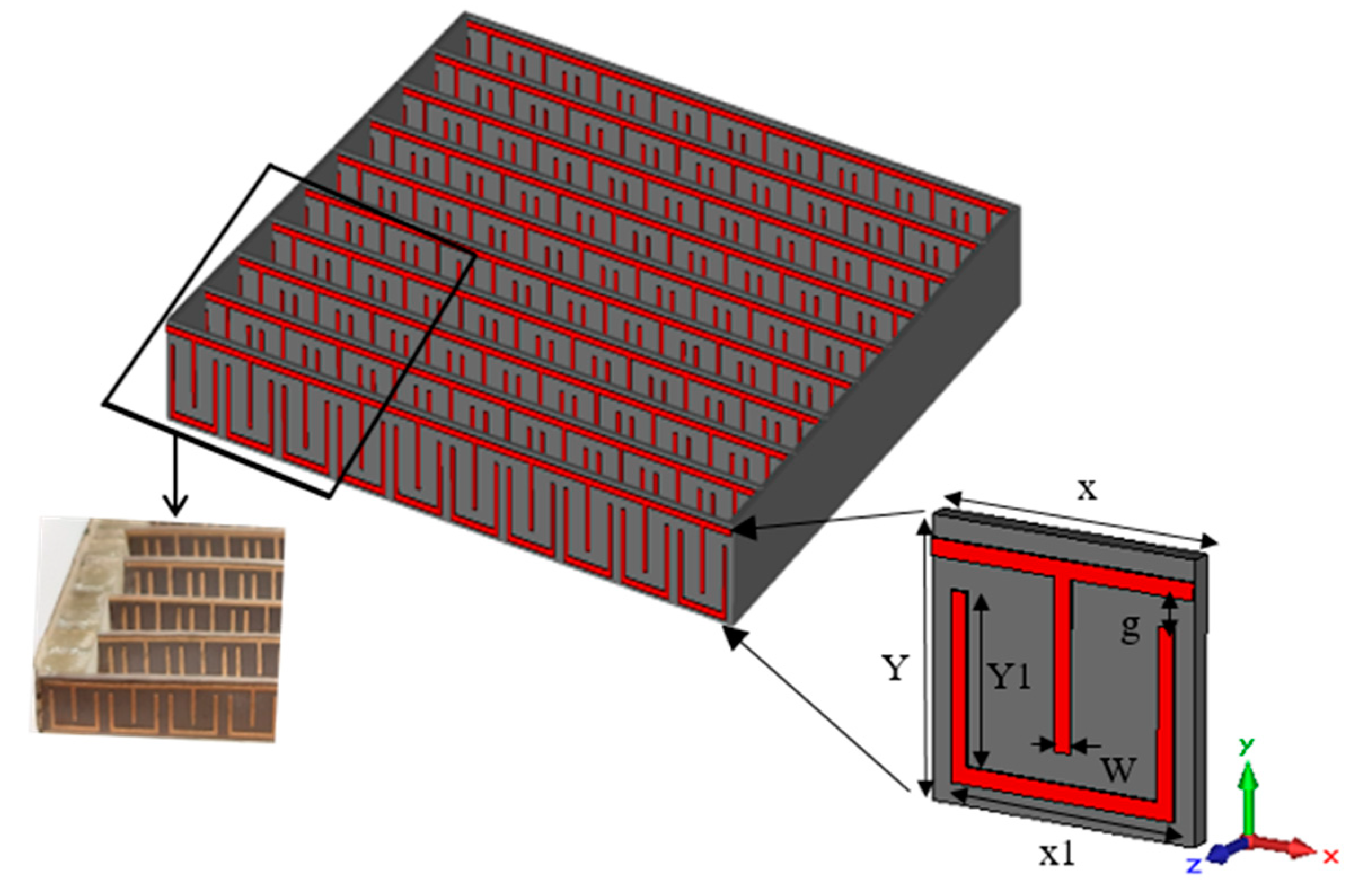
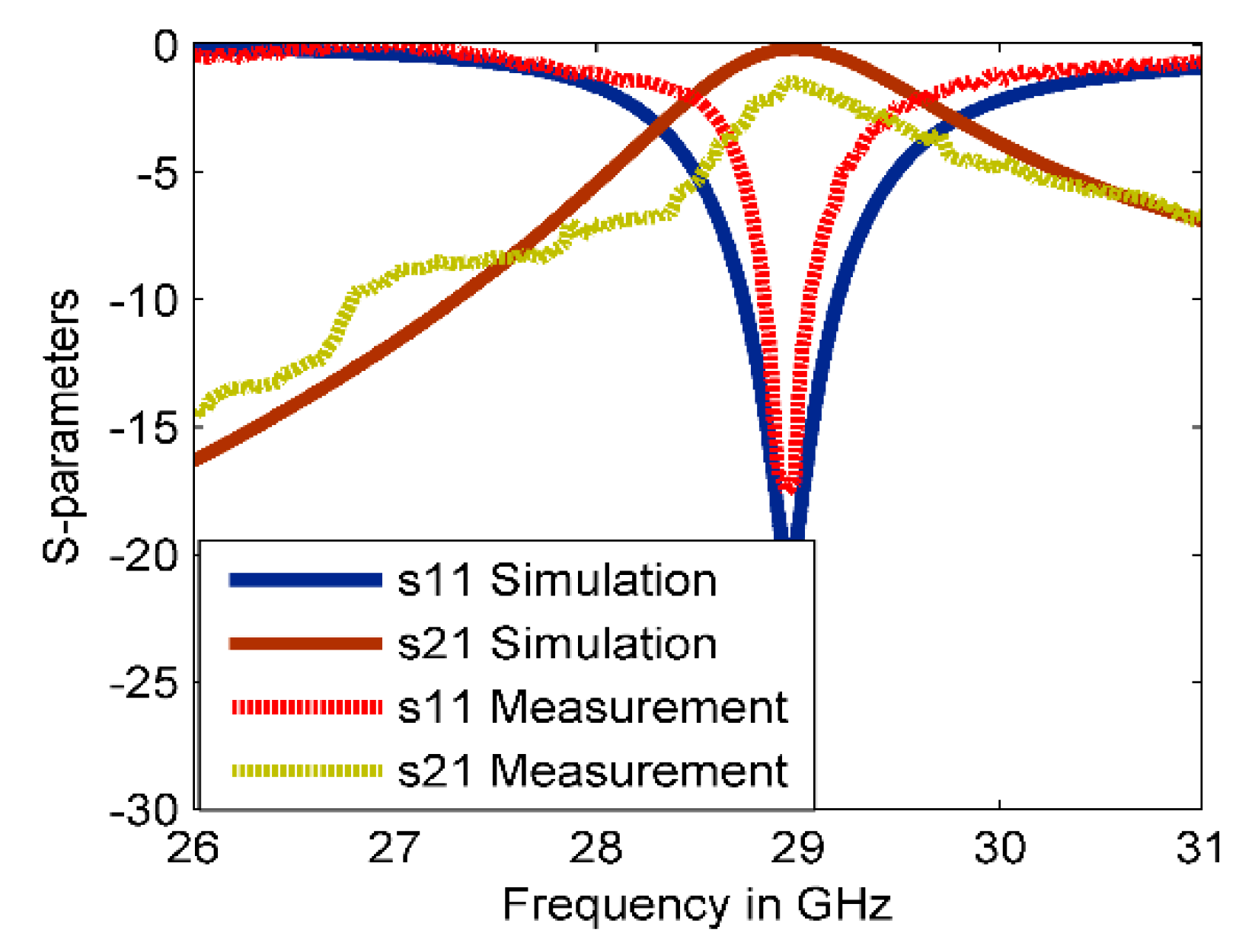
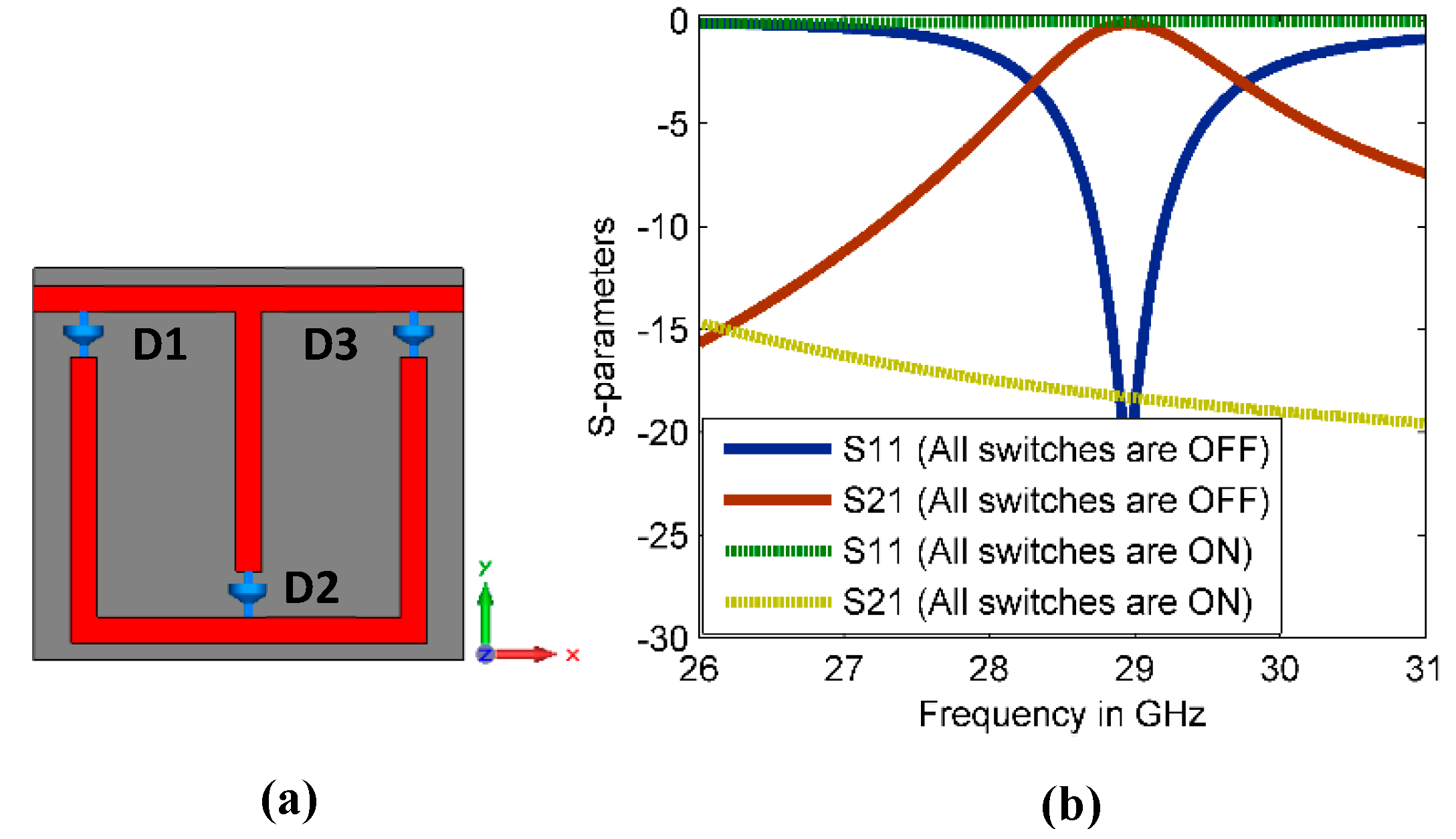
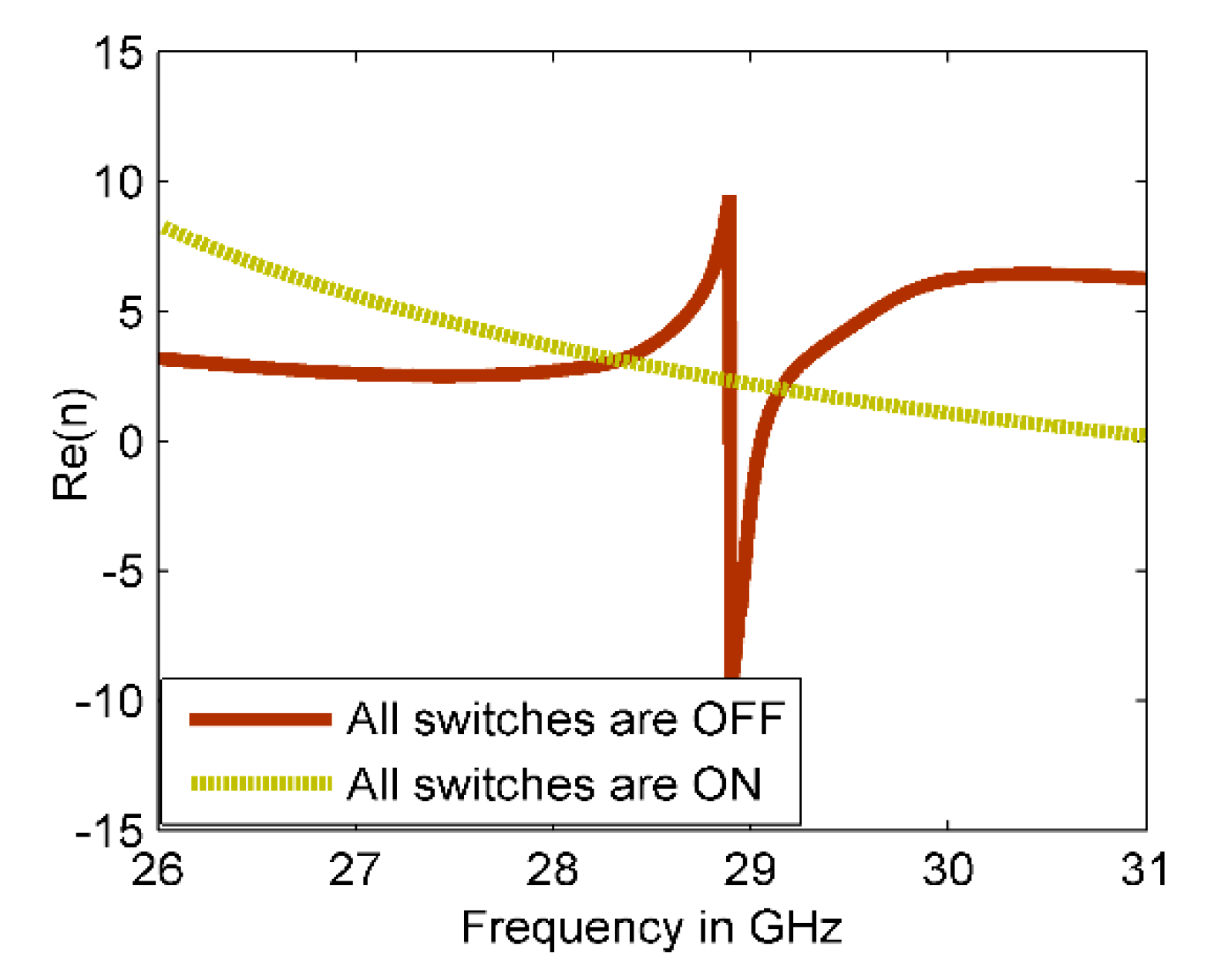


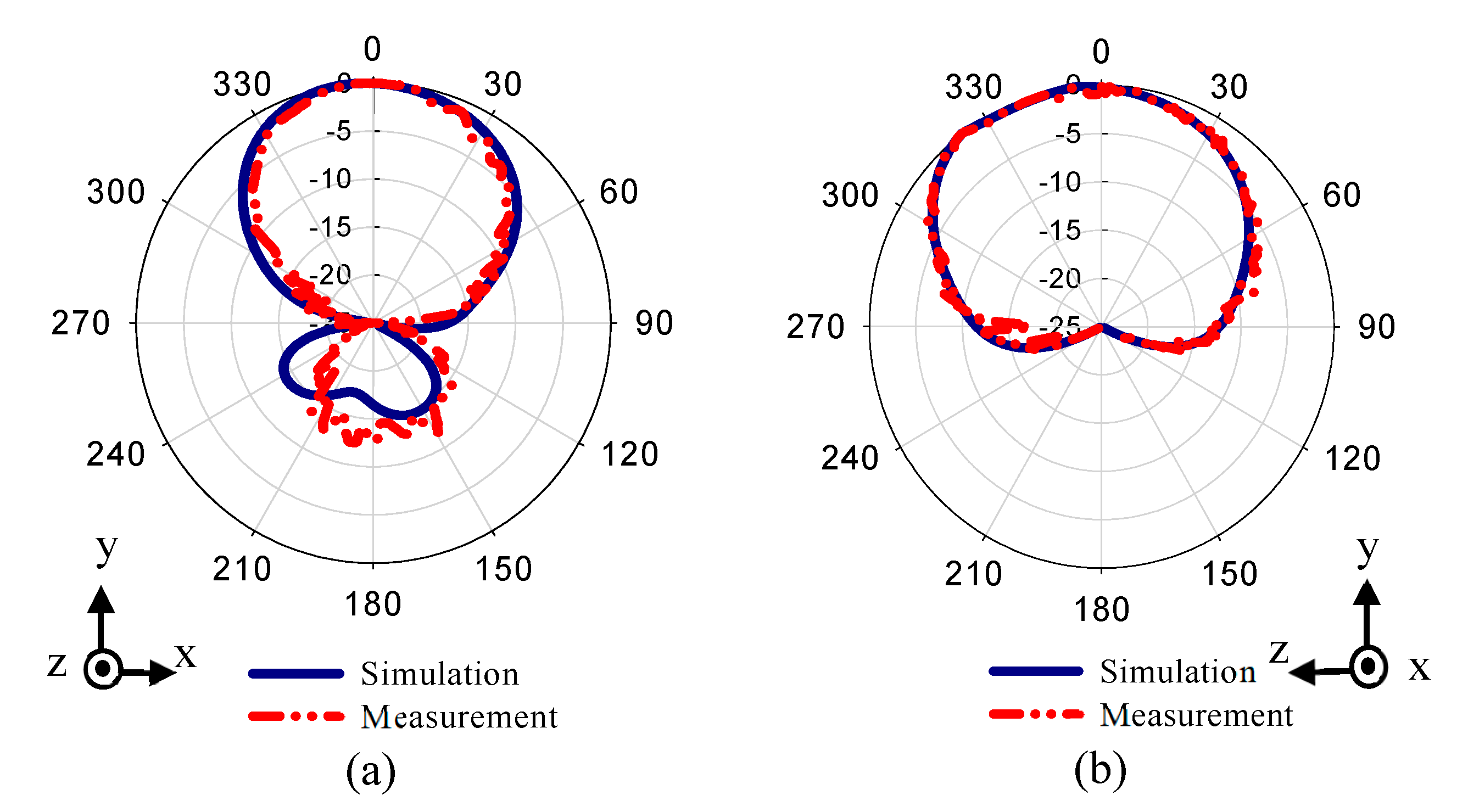

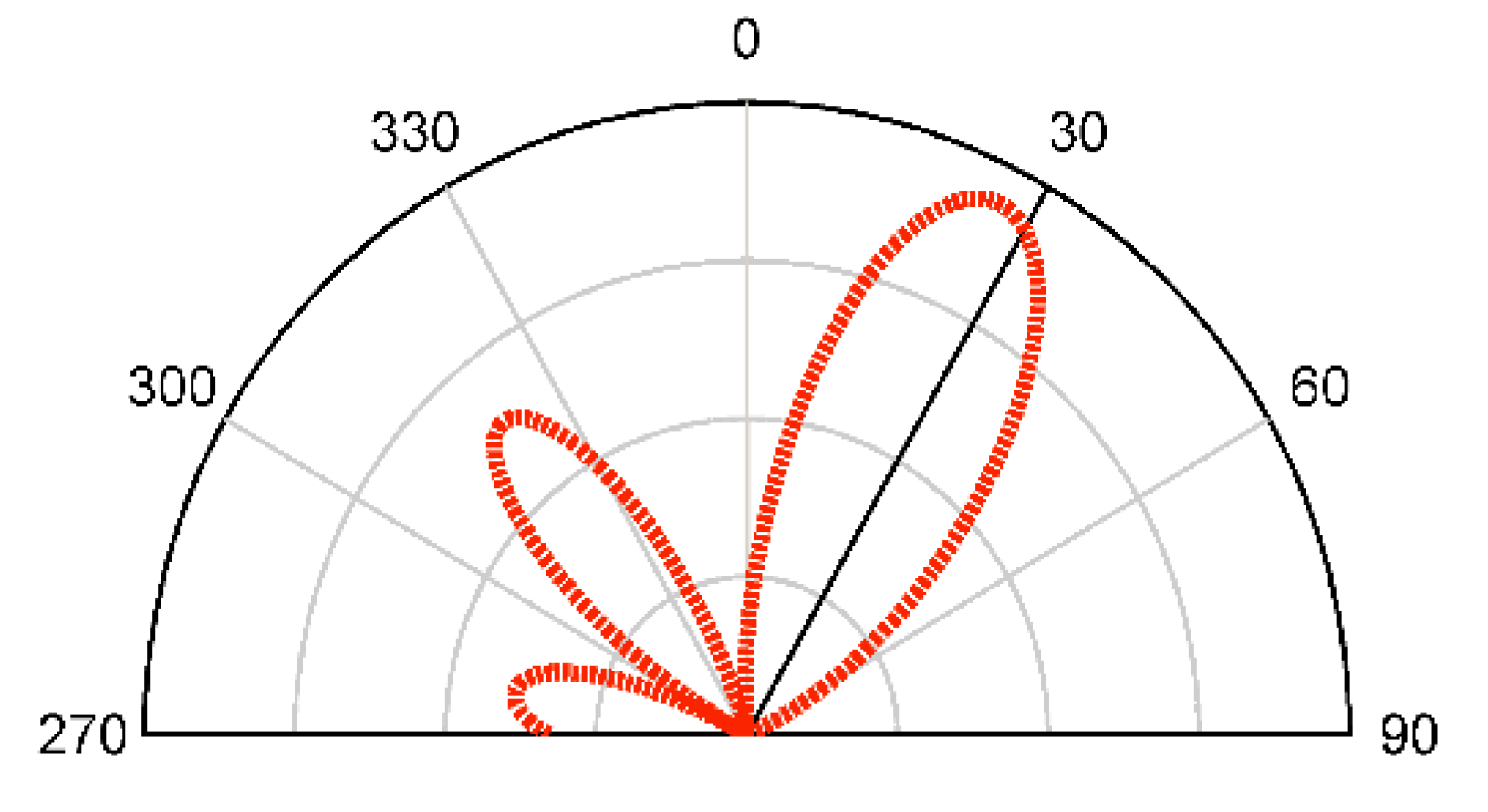


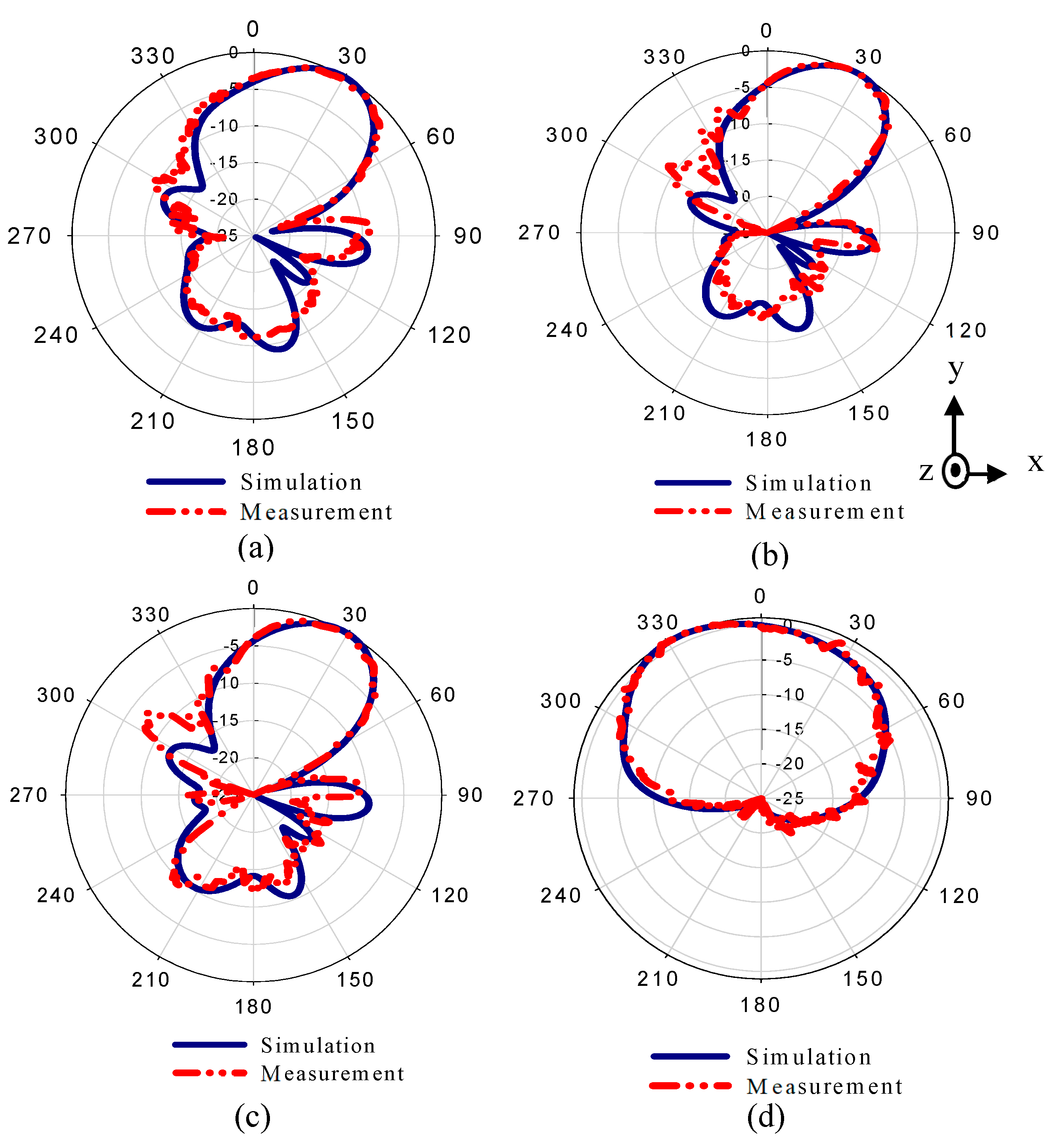
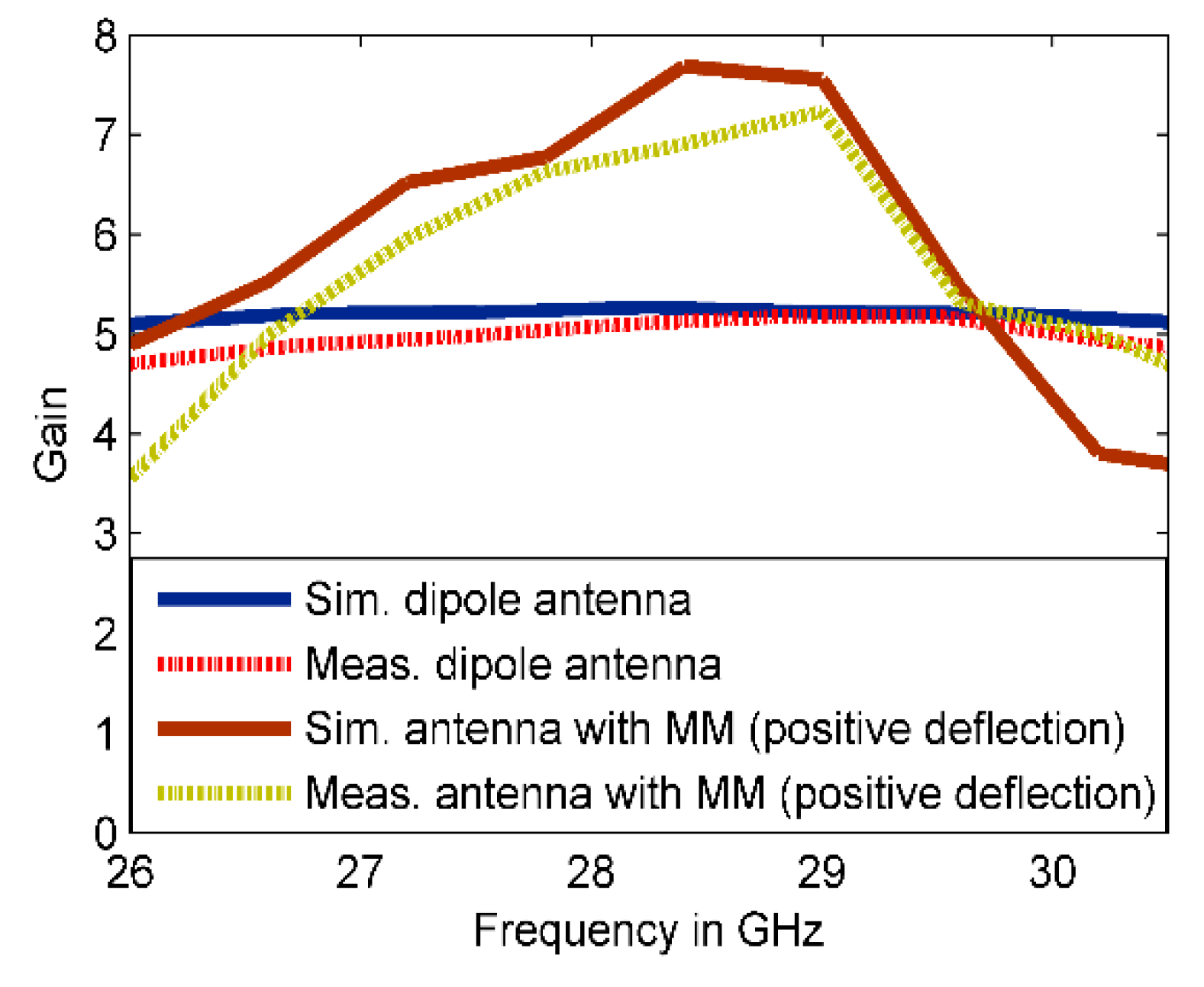

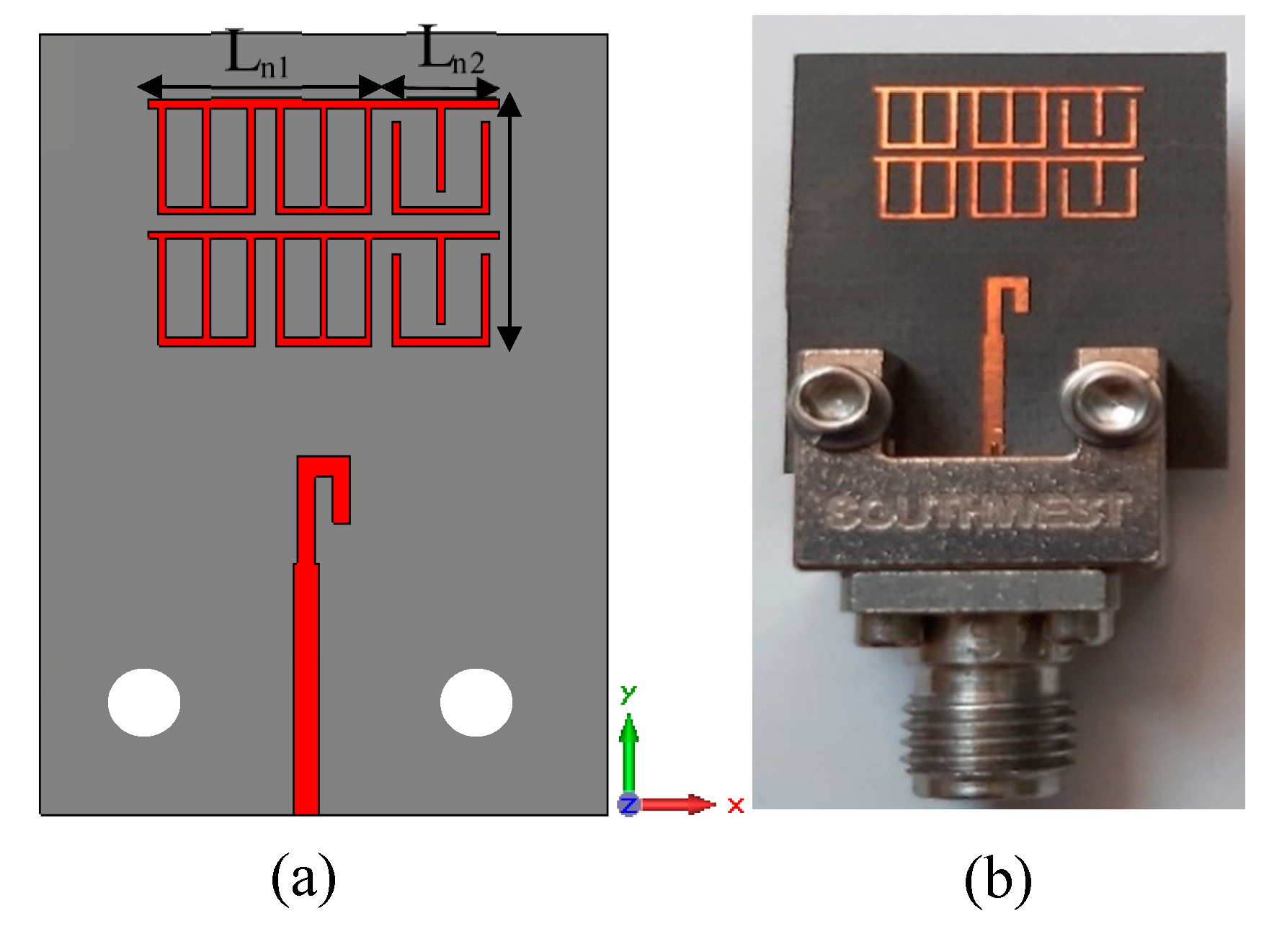
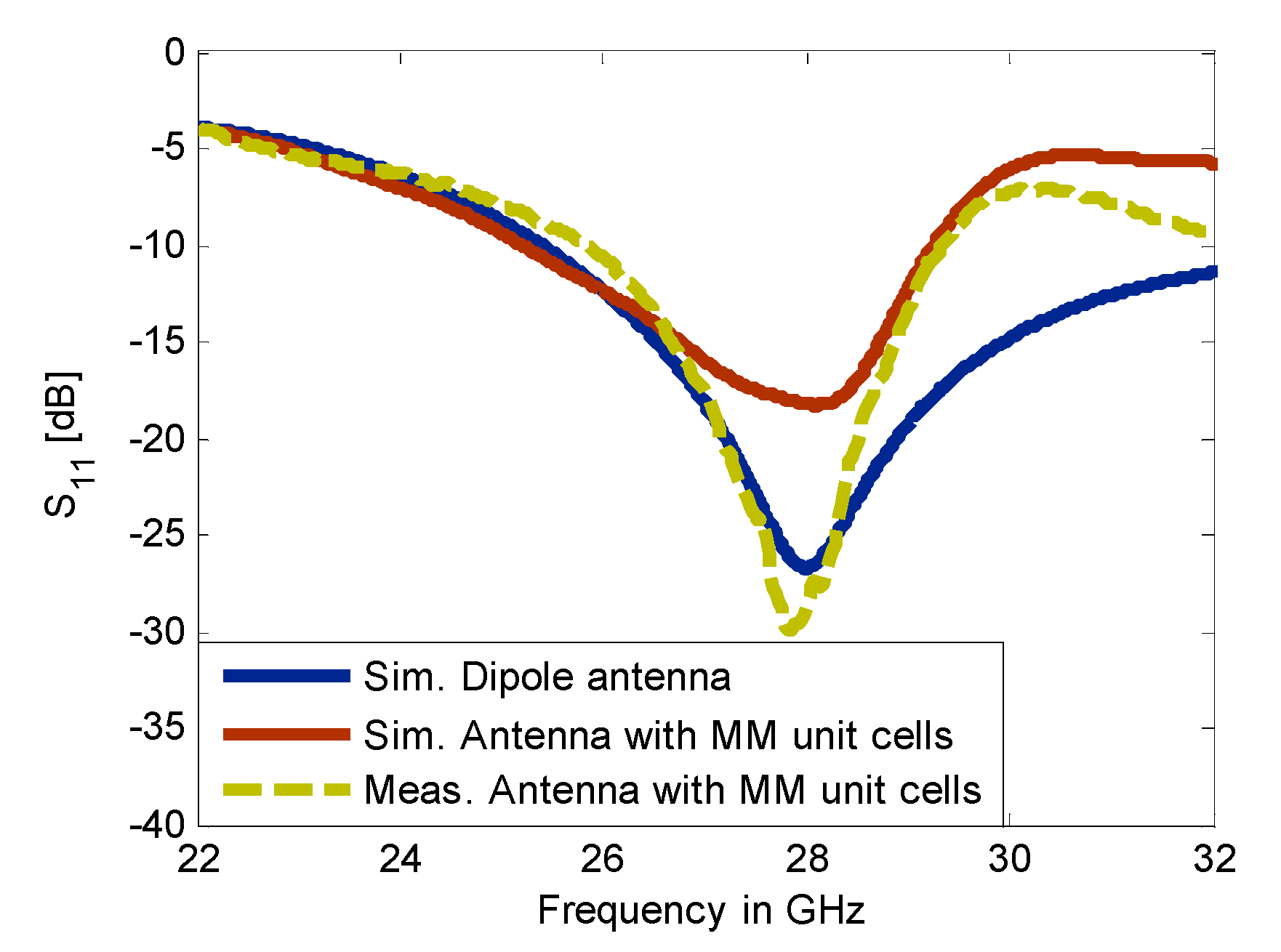

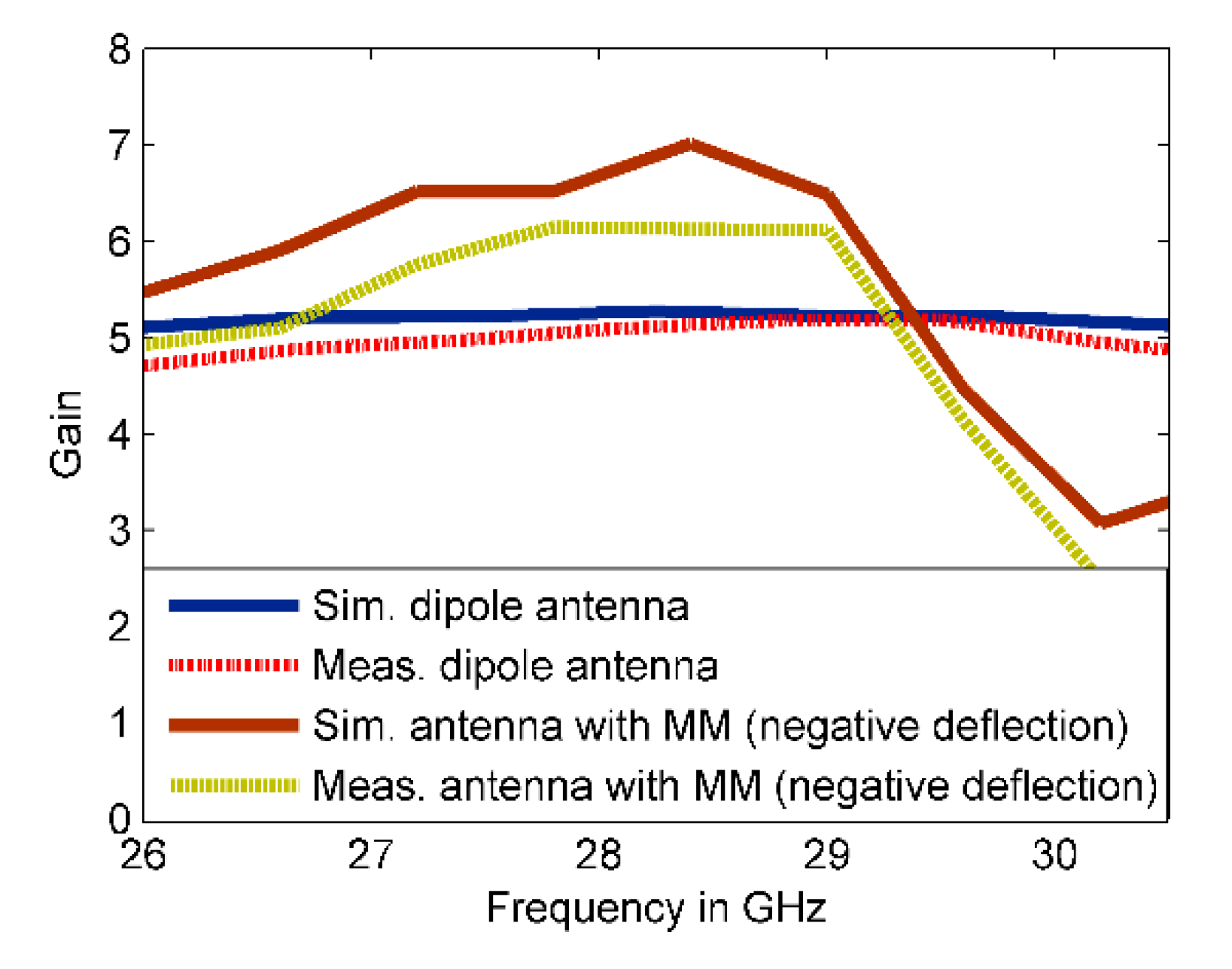
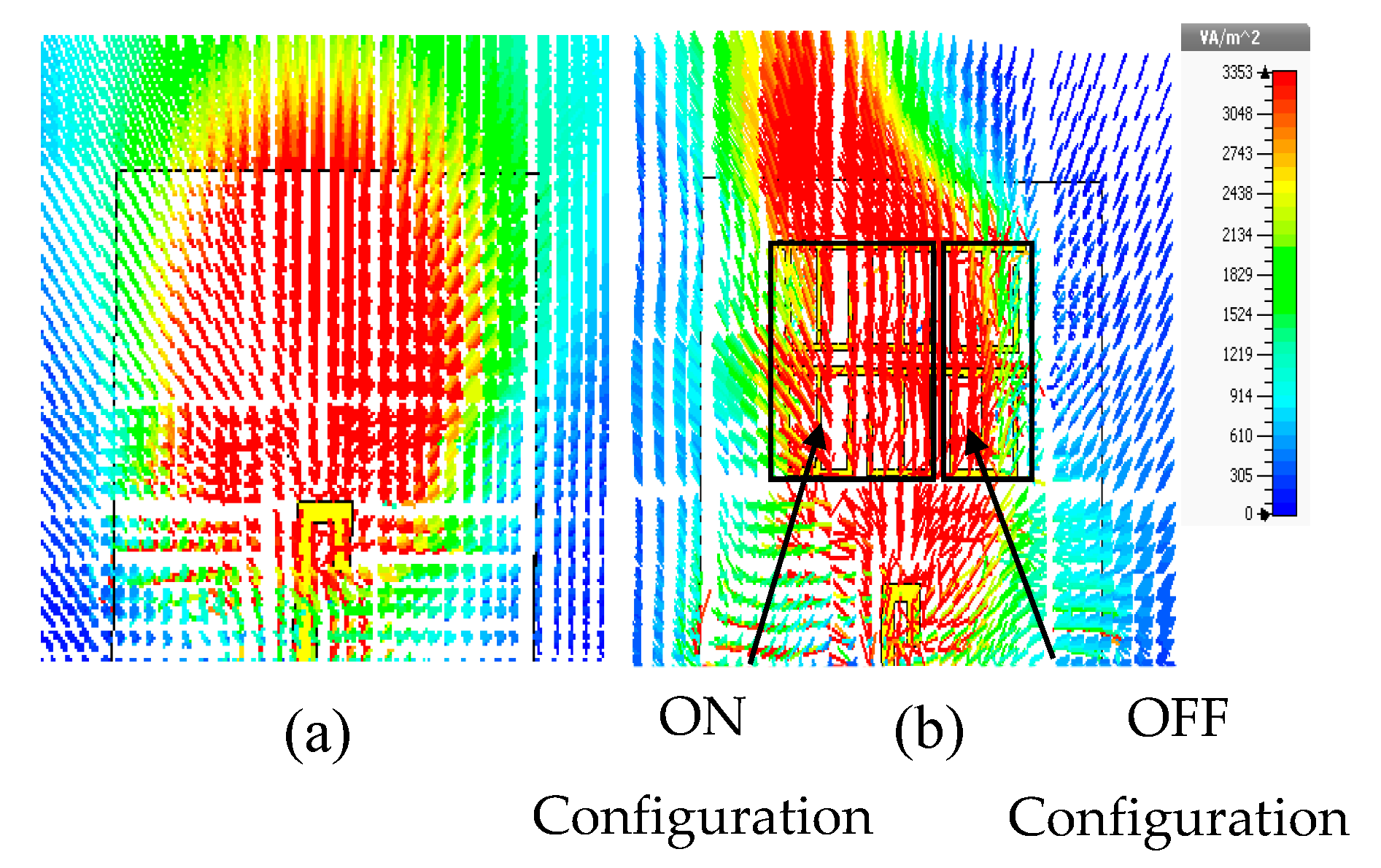
| Parameter | Value (mm) | Parameter | Value (mm) |
|---|---|---|---|
| X | 12 | Ld | 5.3 |
| Y | 16 | Ws | 0.7 |
| L | 5 | Ls | 4 |
| L1 | 2.6 | Ld1 | 1.5 |
| L2 | 1.6 | Ld2 | 2.1 |
| W | 0.7 | Ld3 | 0.5 |
| W1 | 0.5 | Wd1 | 2.1 |
| W2 | 1.55 | Wd2 | 0.8 |
| Wd | 10 | s | 0.5 |
| Ref. | Antenna Type | Frequency Band | Deflection Angle (degrees) | MM Unit Cell | |
|---|---|---|---|---|---|
| Gain (dB) | |||||
| Positive Def. | Negative Def. | ||||
| Positive Gain | Negative Gain | ||||
| [17] | Patch antenna | C-band (7.3 GHz) | 15 | - | SRR |
| Reduced by 1.5 | - | ||||
| [18] | Bow-tie antenna | C-band (7.5 GHz) | 17 | - | H-shape |
| Enhanced by 2.7 | - | ||||
| [19] | Horn antenna | Ku- band (15 GHz) | 10 | - | SRR and H-shape |
| Reduced by 0.48 | - | ||||
| [20] | Dipole antenna | V-band (60 GHz) | 30 | - | HRIM |
| Enhanced by 5 | - | ||||
| [21] | Leaky-wave antenna | X-band8 GHz | 15 | 15 | J-shaped MM |
| - | - | ||||
| [22] | Dipole antenna | S-band3.5 GHz | 25 | 24 | ASSR |
| Enhanced by 3 | Enhanced by 2.7 | ||||
| This work | Printed dipole antenna | Ka-band (28 GHz) | 30 | 27 | CSR |
| Enhanced by 1.9 | Enhanced by 1.5 | ||||
© 2020 by the authors. Licensee MDPI, Basel, Switzerland. This article is an open access article distributed under the terms and conditions of the Creative Commons Attribution (CC BY) license (http://creativecommons.org/licenses/by/4.0/).
Share and Cite
Ali Esmail, B.; Majid, H.A.; Zainal Abidin, Z.; Haimi Dahlan, S.; Himdi, M.; Dewan, R.; Kamal A Rahim, M.; Al-Fadhali, N. Reconfigurable Radiation Pattern of Planar Antenna Using Metamaterial for 5G Applications. Materials 2020, 13, 582. https://doi.org/10.3390/ma13030582
Ali Esmail B, Majid HA, Zainal Abidin Z, Haimi Dahlan S, Himdi M, Dewan R, Kamal A Rahim M, Al-Fadhali N. Reconfigurable Radiation Pattern of Planar Antenna Using Metamaterial for 5G Applications. Materials. 2020; 13(3):582. https://doi.org/10.3390/ma13030582
Chicago/Turabian StyleAli Esmail, Bashar, Huda A Majid, Zuhairiah Zainal Abidin, Samsul Haimi Dahlan, Mohamed Himdi, Raimi Dewan, Mohamad Kamal A Rahim, and Najib Al-Fadhali. 2020. "Reconfigurable Radiation Pattern of Planar Antenna Using Metamaterial for 5G Applications" Materials 13, no. 3: 582. https://doi.org/10.3390/ma13030582
APA StyleAli Esmail, B., Majid, H. A., Zainal Abidin, Z., Haimi Dahlan, S., Himdi, M., Dewan, R., Kamal A Rahim, M., & Al-Fadhali, N. (2020). Reconfigurable Radiation Pattern of Planar Antenna Using Metamaterial for 5G Applications. Materials, 13(3), 582. https://doi.org/10.3390/ma13030582








